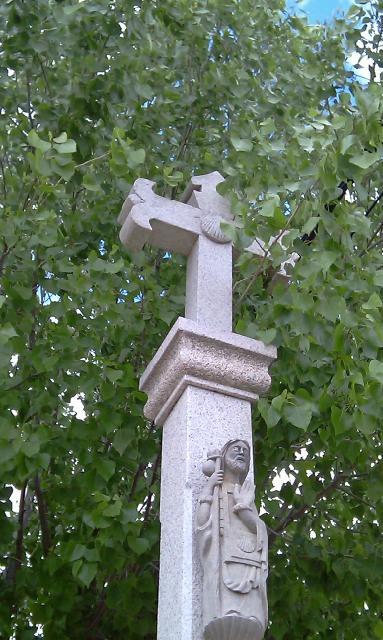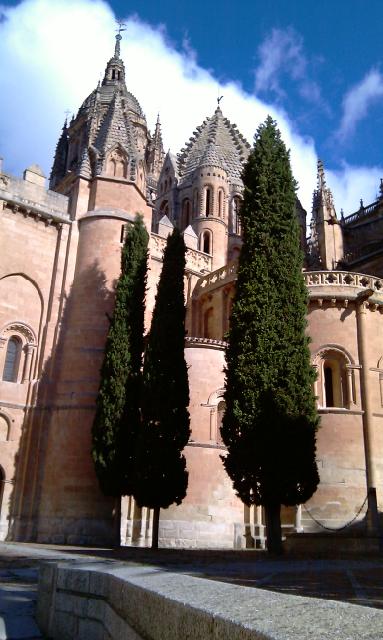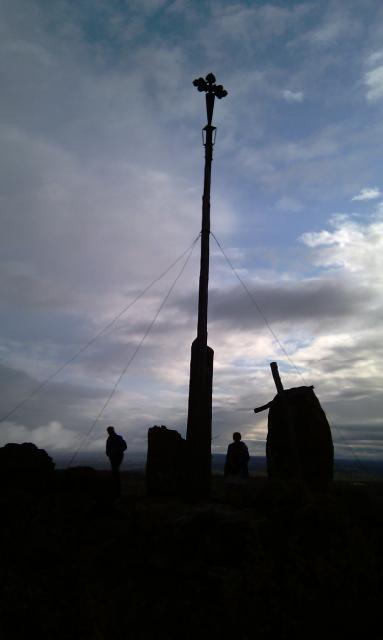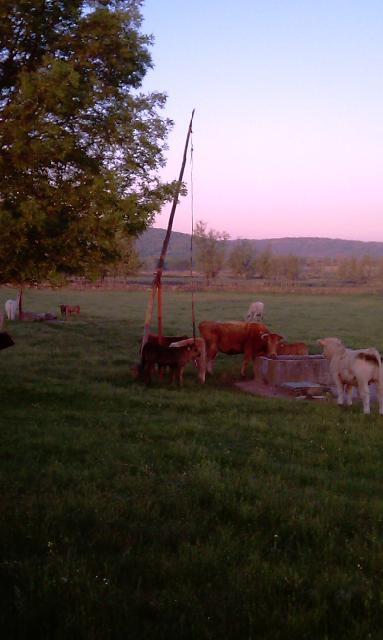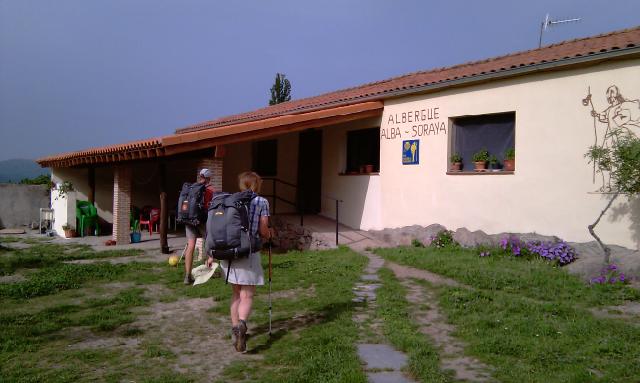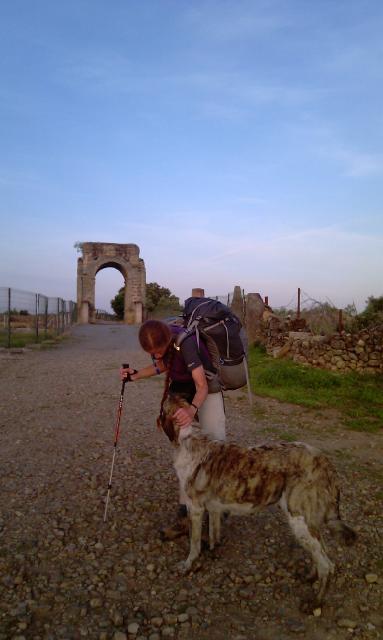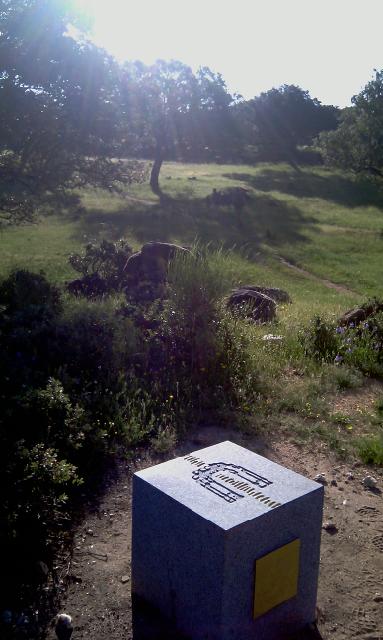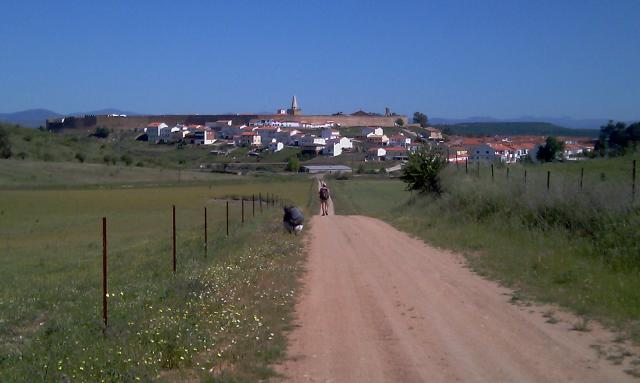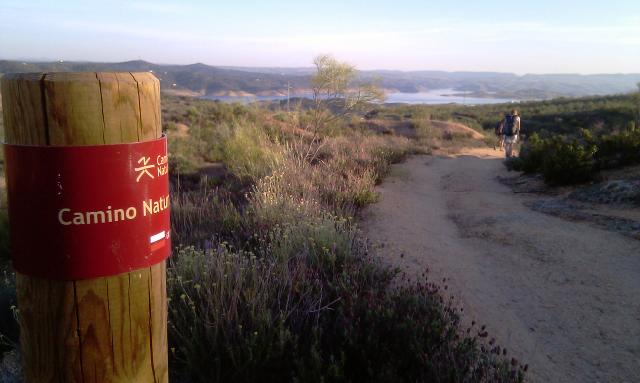20.5 Sunday. San Pedro de Rozados to Salamanca.
We are walking by 5.30 the route to Morille (the next village) is fine in the dark and we race along, mainly because it is cold, after 10km Tim unpacks his rucksac to get at the gloves at the bottom. The ground is fertile, wheat still green and rapeseed in flower, unlike the UK cornflowers and poppies abound at field edges. A noise in the wood edge is a dog whinning, another large hound, black and white it comes straight to be fussed with and stays with us past a farm and to the next one. Soon we can see Salamanca in the distance, but then descend a little and follow the route from the village of Miranda de Assan up on to the hill overlooking a substantial swathe of countryside from where Wellington directed his troops at the Battle of Salamanca (or Arapilles as the spanish call it). There is a small damaged notice board giving details (very largely in English, the Spanish seem ever reluctant to acknowledge the British part in their War of Independence against Napolean).
From there we follow the usual yellow arrows into town and the fine bridge over the Rio Tormes into the shadow of the huge double cathedral of Salamanca. It seems best to think of it a a double as the two buildings are joined but the first was started in the 14thC and the second in the 17thC work continueing on both for centuries! The rooster tower with its huge dome is particularly fine, as is the small spaceman in the restored stonework around the main entrance!
It seems a lively town even on Sunday and with far to much for us to see in the rest of the day even though our rucsacks are outside the albergue at 1030 awaiting opening at 1200 but registration at 4pm.
After registration some of us visit the Art Noveau museum a short distance away there is some nice glass, bronzes and furniture but we are unable to appreciate most of it. It is still cold and thundery around town so we do little else but sit in the alburgue and wonder how early we will be allowed to start our 35+km tomorrow.
Of farewells, to grapes and friends.
21.5 Monday. Salamanca to Cubo de la tierra del vino.
Today is a big day, fortunately the weather is cool and no rain is forecast, the terrain is flat ish. So all that is required is an early start! Our now friends Mimi (the amazing French lady who lives some of the year in Alicante) and Jose (the retired Spanish footballer who played for Madrid in the 60s) also need to start early (both of them normally would do) but have a train to catch to Madrid (and maybe further?). Our hospitalero (in charge of the albergue) has other ideas, he normally unlocks the front door at 7am. The traditional peregrino early morning exit (the fire escape) leads only to a very nice locked garden bounded by the 30m high city walls. Very secure against attack by Moorish forces, but not ideal for an early start! Jose has words! And wins a half hour concession, he is spitting fur and feathers in a torrent of spanish, we explain the concept of a Little Hitler, he agrees. We all are unimpressed by our hospitalero, but we are walking through the main square to go our separate ways by 6.30. We follow the road out of town and northwards it is GR 100 camino N630 and motorway combined but the arrows mostly guide on camino de la tierras out of sight of the autoroute.
The name of the village we are heading for translates as the edge of the land of wine, we sincerely hope not, but it is well recognised that northwards spread the plains of Castille, the bread basket of Spain and a land of corn rather than vine that we walked through the north of on the Camino Francais 4 years ago. During the day we see a few cows even fewer sheep and goats and one patch of oak pasture. The landscape has changed from the Constablesque tree shaded pasture to the green seas of corn with occasional tractor ships and lighthouse grain silos. No hounds join us and we tread these seas alone.
We arrive a bit cold and windblown are welcomed by Senor Felipe a dedicated hospitalero and after a shower and washing done, dispatched down the road with a phone call to Casa Carmen, Carmen the plump elderly lady of the house welcomes us to the parlour with an open fire where she has just served lunch to her husband, we join him for a lentil/pasta stew followed by Pollo y Fritas and salad washed down with red wine with flan for pudding. We feel much warmer immediately, and discover this is from the live embers in the dish on the floor under the table. Even the senor agrees that this may be a fire risk but it seems well worth it to us at present.
A good siesta and the world is much better and a walk around the village reveals an old church(locked) and a newish santiago cross outside. The albergue is a member of the association of villages supporting the camino and pilgrims bring economic support into
the village, but even so its population is shrinking.
38km 7.30hrs
Cathedrals and Spacemen, Bridges and Battles.
20.5 Sunday. San Pedro de Rozados to Salamanca.
We are walking by 5.30 the route to Morille (the next village) is fine in the dark and we race along, mainly because it is cold, after 10km Tim unpacks his rucksac to get at the gloves at the bottom. The ground is fertile, wheat still green and rapeseed in flower, unlike the UK cornflowers and poppies abound at field edges. A noise in the wood edge is a dog whinning, another large hound, black and white it comes straight to be fussed with and stays with us past a farm and to the next one. Soon we can see Salamanca in the distance, but then descend a little and follow the route from the village of Miranda de Assan up on to the hill overlooking a substantial swathe of countryside from where Wellington directed his troops at the Battle of Salamanca (or Arapilles as the spanish call it). There is a small damaged notice board giving details (very largely in English, the Spanish seem ever reluctant to acknowledge the British part in their War of Independence against Napolean).
From there we follow the usual yellow arrows into town and the fine bridge over the Rio Tormes into the shadow of the huge double cathedral of Salamanca. It seems best to think of it a a double as the two buildings are joined but the first was started in the 14thC and the second in the 17thC work continueing on both for centuries! The rooster tower with its huge dome is particularly fine, as is the small spaceman in the restored stonework around the main entrance!
It seems a lively town even on Sunday and with far to much for us to see in the rest of the day even though our rucsacks are outside the albergue at 1030 awaiting opening at 1200 but registration at 4pm.
After registration some of us visit the Art Noveau museum a short distance away there is some nice glass, bronzes and furniture but we are unable to appreciate most of it. It is still cold and thundery around town so we do little else but sit in the alburgue and wonder how early we will be allowed to start our 35+km tomorrow.
High Points, Cold Fronts, Orchids and Crosses.
19.5 Saturday. Father Blass at Fuenterroble de Savatierra to San Pedro de Rozados.
After our lunch, in the nearest restaurant in which Jose (our professional footballer) turns art critic over an abstract painting and confuses the owner (possibly artist) by seeing people in it, we sleep in our cave in Father Blass’s ever extending albergue. He finishes the concrete and turns to laying a wooden floor. We sleep again, it is a restful place, after a bit more food eaten out the back next to the shed with the carts for parading the saints effigies, and then start walking at 5.30am.
There is a change in weather forecast, a cold front may bring rain by 5am.
It is however not raining when we start but very dark, cloud no moon, no dogs creep up behind us, and we find our way to the roman road across the fields without difficulty. Rain threatens and in torchlight we eat a hurried breakfast while donning waterproofs.
The day continues cold with intermittent drizzle and we climb from a base of 900m in classic cow country (like England or France) to a peak (small hill) at 1170m, this to some extent explains the temperature and the change in flora. There is a brief halt when Betsy claims to see a large bird in a tree and refuses to believe that it is “only stuff”. The dispute is only resolved when the “stuff” takes flight in the shape of a vulture! Other interesting bird moments include actual sightings of some of the secretive but noisy cuckoos and a flock of 13 storks which fly in front of us. We see deciduous oak and ash instead of cork and olive trees at the side of the road, and, on the slopes of La Duena, the highest altitude (it is a hill not a peak) on the Via de la Plata camino, two different species of orchid in prolific clumps. Also a surprisingly english looking bluebell wood. On the route up Father Blass and his helpers have been busy for a few years erecting crosses to celebrate Easter, Betsy says there should be 13 (or was it 12) stations. We only see a few of them before the grey wet encloses us and the world shrinks to the wet grit beneath our feet bordered by a nylon hood. Happily we reach San Pedro (fortunately no gates) about half an hour later, and a Casa Rurale at which we gratefully stay.
Over our afternoon nap the skies change from grey to blue with large white clouds and the world is a brighter place.
28km 6hrs Tomorrow Salamanca.
Nodding donkeys and Baby storks.
18.5 Friday. Calzada de Behar to Fuenterroble de Salvatierra.
Walking a camino can be a gradual getting to know people, one tends to see some of the same day by day as they move at the same speed, others are ships that pass in the night, noticed but unknown, last night we learnt the proper name of Mimi who covers the same ground as us at twenty years older with less apparent effort. She is Marie Antoinette! Jose who was a professional footballer playing for Real Madrid in 1966 was disappointed to learn of our lack of interest in the sport inspite of our nationality.
Not a big day and mostly over 900m so with cooler weather we stary later, taking full advantage of desayunos (breakfast) offered at the albergue (just as well no bars open en route till gone 10.00hrs).
We leave the hamlet with two storklets on the church bell tower at about 0700. It is light (tomorrow may be difficult, no moon) and we do not stop to visit the two donkeys behind the albergue, the walking is good in the cool temperatures and we move well on about 50:50tarmac and dirt road. Cuckoos and hoopoes are heard on all sides and a pair of Orioles cross in front of us.
A sign in the village about local paths and interests suggests that the local wells have an interesting type of device for raising water, the name translates as “baby stork”, they are more like the nodding donkey oil pumps of texas history, either name would seem appropriate.
We pass a tepee constructed by a visiting ladies basket ball team!? For the use of pilgrims. And soon arrive in Fuenterroble at the albergue of Father Blass who is laying concrete. His fame as a sort of latter day Santo Domingo (14th century builder of bridges and roads on Camino Francais) is well known and his albergue is capable of holding up to 90 pilgrims, a coach is just leaving. There is a three room part for American pilgrims which may in part explain the teepee, and the basket ball court on the left on entering the village. Whatever, the albergue is donativo and very well cared for with a load of bits and pieces from the camino stashed arround and a room with a couple of dozen old spanish saddles.
The albergue is liberally decorated with mostly camino related murals and Father Blass’s energy appears to stretch to a complete refurbishment of the parish church (with reconstructed roman road beside it) and multiple statues of St James.
20km 4.15hrs.
Eternal springs
17.5 Thursday. Aldeanueva del Camino to La Calzada de Bejar.
Having marched into the valley and gained height yesterday to 500+m, so we know that today we have to go over the pass at the end. This is 870m and the end of Extremadura, we see the Guarda Civilia turn their car in the petrol station on top, presumably the end of their beat. We are now in Castille y Leon. The temperature drops to comfortable levels as we climb through Banos de Montmayor a little spa town based on springs flowing out of the side of this steep sided valley, these continue as we climb on the old roman road up to the pass. Up here we are in deciduous forest and green pastures that could be Derbyshire, chestnut trees and a deciduous oak species dominate it is cool and pleasant walking along the drove route of the Via Pecuaria. We descend quite steeply to the bridge over the Rio Cuerpo de Hombre and up a little to the Alburgue Alba-Soraya on the col at La Calzada de Behar. As we arrive a troup of maybe the Spanish equivalent of the Territorial Army marches down towards us all in khaki and fully armed (with Hi Vis jackets to front and rear). This little albergue is run by Manuela and Juan Maxi and named for their children and is very welcoming. The weather is windier and cooler today even allowing for the elevation of nearly 800m and sitting outside Betsy thinks she may need a pullover but it is a very pleasant relief from the heat.
23km a bit over 5hours and 500m of ascent.
Dogged Persistence.
16.5 Wednesday. Oliva de Placencia to Aldeanueva de Camino.
The little village with its sole accomodation has served very well. Monica the hospitalero is very helpful with good english, though prices reflect the lack of comptition. She also collects and delivers punters from the arch on the Via de la Plata at Capara. This is the amazing isolated roman arch on the camino that is the template for all the granite cube waymarks in the Extremadura camino.
We alone of those staying overnight are walking back to the arch which we have not yet seen, so we start at 6am in the dark and as directed find the dirt track leading back to the camino. We have not been striding out by moon and torch light for long when we have a sensation of being followed!
Turning almost together we are confronted by two huge dogs, they are the typical sheepdogs of the drove paths. For a moment thoughts of spectral hounds or being eaten come to mind, then one advances cautiously tail wagging very slightly, a sniff at Betsy’s hand and they deign to allow the familiarity of ear scratching! They are a dog and a bitch and pad along with effortless ease escorting us to the arch and eventually with the other walkers 26km to our next town, with a few deviations, like 10secs to cover 200m in pursuit of a hare they set up. These mastiff like dogs covered huge distances in the past escorting herds of sheep acoss the drove roads of spain and although we left them 26km at least from home the route of the Via Pecuaria is probably embedded in their DNA. It is a little sad to see them head off into the countryside although at one point stirring up a herd of cattle they almost caught us in a stampede.
The route is once again through oak forest pasture land, looking like English stately home parkland and after the arch and its associated archeological site we are 10km before a bit of road with the ground rising slowly to about 500m small streams are common with good water flows as we approach our destination of Aldeanueva. Looking up we see why – there are mountains ahead and to the sides, amazingly with the afternoon heat there is still some snow around the tops at 2300m.
We find the little 8-9 bed municipal albergue on the left in the small town. It is only a couple of years old, and free. It is clean and has hot water when, after our showers, we find out how to work it. At 500m it is not quite so hot as lower down so the day, as promised by Mimi (the remarkable 76year old frenchwoman on her tenth camino and second Via de la Plata) who we have been meeting on and off for days, has been quite quick and pleasant.
A very good lunch at the Restaurant Sebas and a siesta round off the day.
26km 5.30hours.
Of Sandwiches and Spells.
15.5 Tuesday. Galisteo to Oliva de Placencia.
From Galisteo along the Via de la Plata there are 49km, too long a day for us in this heat, we agree to break the distance in Oliva de Placencia, this is 10km off route but means a total increase in distance of only 6km over the two days.
The alternative is a night spent out in the delightful oak pastures we walk through over these two days, without showers or water (let alone a square meal), we are not that hard core!
The day planned is a sandwich with a suberb filling of oak shaded pastures (that seem more verdant than lower down) and granite boulders this tasty meal covered by a rather stale 10km of ashalt at each end.
We set off at 5am after breakfast in the albergue (supplied the night before) and today Betsy says the spell is different??
Yesterday there were two bats, a toad and an owl hooting before dawn, today four or more bats and a snake. Spotted by Tony as dead and dried up in the road, but very much alive and slithering into the grass when headtorches shone on it (about a foot long). What the purpose of the spells is Betsy does not divulge, maybe to ward off heat, we hope she gets it right, too many bats may mean rain!
After the first 10km in the dark on roads we reach Carcaboso by 7.30, a respectable 5+km per hour. There is an open hostal/cafe/restuarant on the main street only 100m from the route through town. Coffee!
We are soon off again and the route steepens in a steady climb up from 280m to 400+m, this plus the shade from the wonderful oak pasture we walk through along the old roman road that defines this section of the Via de la Plata allows us to remain cool and make good time through some of the best walking this trip. Cows and cuckoos are herd and seen on both sides of the way and Tony spots another snake in a large puddle of tadpoles it seeks the mud and plays dead when it is fished out for photographic purposes. It is returned to its muddy gastronomic heaven where we leave it.
The Way is well marked through this part the green and yellow flashes on the sides of the granite cubes indicating the route indicate footpaths only or cycle, 4×4 routes,(according to a sign we see), we earlier thought these were the Camino and the Via de la Plata or Via Pecuaria (drove road), these names are not mutually exclusive and considerable overlap exists on maps and on the ground.
All too soon we reach the road to Oliva de Placencia and our second bit of stale bread, its a bit heads down in the sun for 8Km but there are storks, kites and cuckoos to distract us from the tarmac, so sooner than we thought we reach the village and its small albergue touristico, to be welcomed by the hospitalero Monica who is a fund of information, and as first arrivals the three bed Dormitorio 1 is ours for the taking. She also cooks supper for those who wish, (not quite the only show in town as the Bar down the road also does tapas and menus) the village shop closes at 1300hrs we were in time to purchase tomorrows oranges. Tomorrow we should see the real object that decorates the tops of the granite cube signs, the remarkably preserved Roman arch back on route and only 6km away at Caparra. We are told by a Spanish walker the next two days are the best in Estramadura!
The locals are a bit devious.
14.5 Monday. Canaveral to Calisteo.
A night sleeping in aircon in Hostal Malaga worked wonders and having managed to pay for our room and board in the evening, the over worked landlord being understandably reluctant to provide breakfast when we insisted on leaving at 5am, we set off once more into the dark. Only one false move of 200m and we are loping along, once more the camino follows the Via Pecuaria first steeply up then more slowly into oak and cork pastures. The day dawns, the route undulates up and down, following the border of a subregion or large estancia, at one point a herd of cows are watched over, not by the conventional large dog, but by CCTV! !?
At one point we descend a shoulder of pasture above the Embalse de El Becheron past the dam, down to a road and the bridge over the dam outflow. At this point there has been some messing with the signs, the official route which we took goes right up the road about 400m and turns left (well signed with the official granite cubes of Estramadura) up a good dirt track to higher pastures and a distant view of the old walled town of Gallisteo, our destination. Descent down the track leads to a large concrete irrigation channel and offical block signs to the right alongside it. After 200m there is a block pointing the green route (not camino yellow) down an overgrown path which may link up with the route later. Further on just under a km is a locked gate with signs saying no camino. We believe this to be the correct route and climbed the gate, passed a deserted farmhouse to its left and picked up a good track again. Down over another locked gate passing an active farm on the right and meeting signs from the indicated green route at the bridge over a stream covered in poplar seeds in snow drifts over it. At this point normal signs resume and after a steep hill the town of Galisteo appears walled but welcoming.
The Alburgue is at the bottom on the right of the road up to Puerta Santa Maria a gate through the old walls of the town.
A good days ramble in the old tradition. 27km 6 hrs. Its getting very hot now at 4pm and several turning up at the albergue seem to have taken a different longer route!
A wedding, the storming of the albergue, a walk in the dark.
13.5 Domingo. Sunday. Casar de Caseres to Canaveral.
Todays walk is 34-36km in the information we have, different opinions abound (including 40km from three amiable young drunks thinking about going home at 5am) so a very early start is indicated. We are outside town walking on headtorches by 5.30. The route along the drove route rises slowly through an area of granite upland with good pasture and large boulders or cows just over the drystone walls on either side. In our torch light the difference seems to be the presence of large green eyes. First light appears behind what is probably a service area on the distant autoroute (blue lights surrounded by white) but may be an alien spaceship. The light becomes slowly better and without torches we see foxgloves, just blooming, growing in the cracks and gaps in the large tors of rock on either side of us. By 7.30 the sun has just become an orange glowing above our eastern horizon.
It was a hot quiet day in Casar yesterday, we and most of the alburgue were in bed by 9 expecting an early start, noise outside gradually increases, sleep at an early hour in town in a spanish town on Saturday night is difficult but this sounds like a riot. Then the band starts, not guitars and hard rock but a brass marching band with drums. Looking out from the first floor balcony windows of the dormitory in the imposing old pile in the main square that is the alburgue there is a sea of people many in full dress and then the bride arrives! A group of young men climb the balcony go open our front door and usher her up, all drunk but very aimiable. Tony is looking out of the window and somehow ends up on the balcony in his night shorts with the bride, the crowd roars with approval flashguns pop, he is rapidly replaced by the groom.
Photo call finished the band strikes up and a procession gradually fades into the distance, a little late we manage to fall asleep in the heat.
Back on today the day warms up and we reach the Embalse de Alcantara crossing two bridges with our old friend the N630 who appeared from out field. We pick up the GR113 just before the first bridge, one of Spain collection of secular footpaths and follow it over rocky pasture with several stops, at one near a cattle grid, Tony spots the biggest lizard any of us have seen in europe, about 15″ nose to tail.
Betsy is now fading fast from the heat and the water fountain at the entrance to the village, UP the hill from the little16th century bridge nearly proves too much. After that a short stagger through the village to the Hostal Malagar (air con) and our room for the night. After food (rabbit stew) and a siesta and copious water we all feel better, the next day is a bit shorter.
33km nearly 8 hours.
